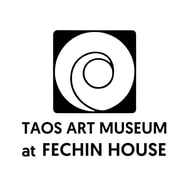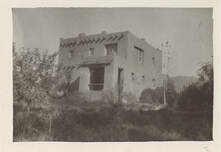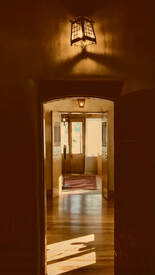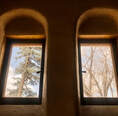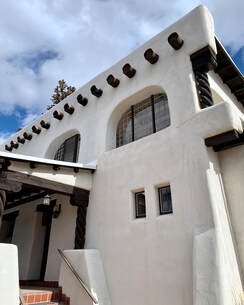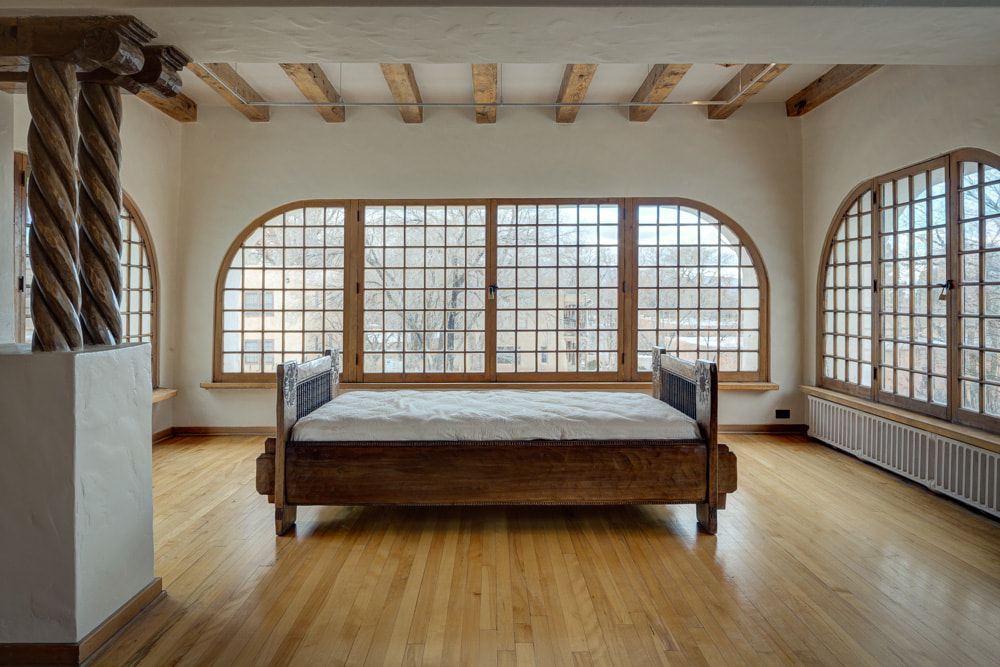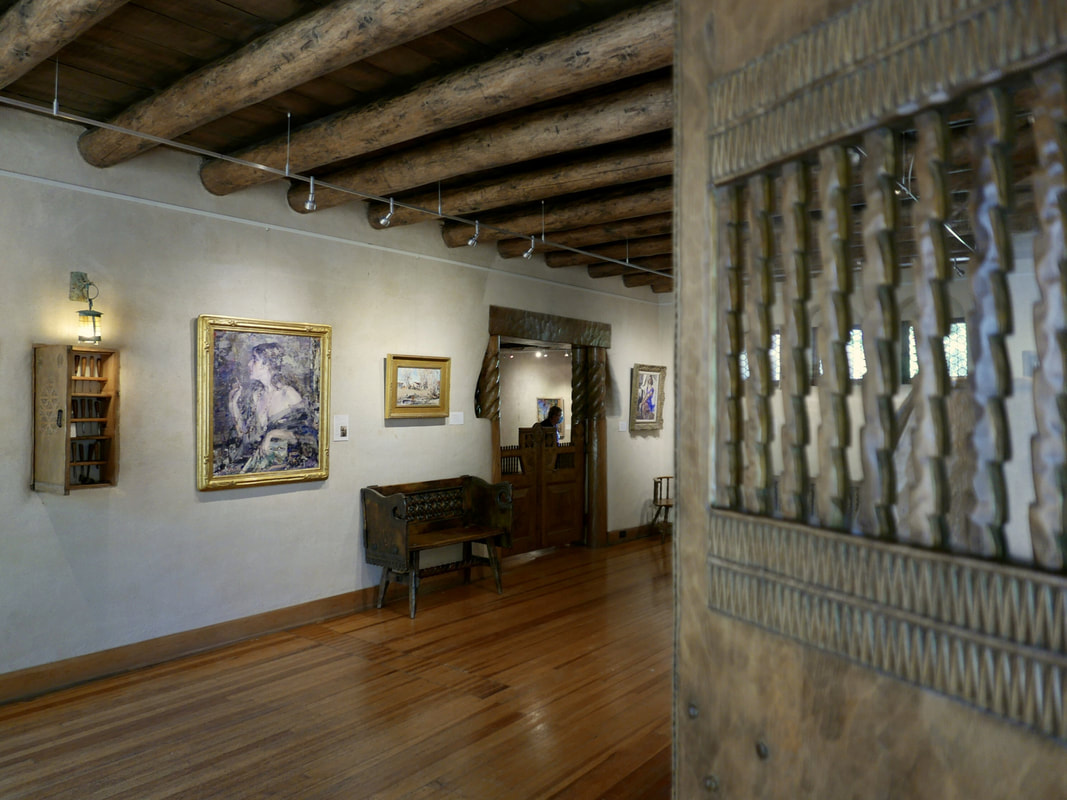|
In 1923, renowned Russian-American artist Nicolai Fechin (pronounced "fay-shin"), his wife, Alexandra, and their daughter, Eya, emigrated from Russia to New York City. In 1926, at the invitation of Taos patroness Mabel Dodge Luhan and the encouragement of artist John Young-Hunter, the Fechin family traveled to Taos and spent the summer at Mabel's place. Then, so Fechin could have the privacy he desired to paint, the family decided it was time for their own home in Taos. In 1927, they acquired the property of Dr. J.J. Bergmans and his wife, Wilhelmina Harkink-Bergmans, who were returning to their native Holland. The Fechins moved into the house until March of 1928 when they concluded the two-story, eight-room, cube-shaped symmetrical adobe failed to satisfy their needs functionally or aesthetically, and they would have to remodel.
|
|
For the next five years, the Fechin family labored to make the home theirs. Nicolai planned, and the multi-lingual Alexandra communicated directions to Miguel and Pedro Mirabal, masons from the Taos Pueblo, and Joe Martinez. Nicolai worked day and night. The Fechins' workmen removed all interior, non-load bearing walls and reconfigured the space. They doubled the size of the front porch and added a series of rooms that projected from what was once the central cube.
The construction coincided with the arrival of electricity in Taos in 1928 and a modern sewage system that arrived in 1930. Electricity made it possible for Nicolai to carve and build at night while he painted during the day. The electric stove, oven, and refrigerator were the first in town! With the new sewage system, Fechin went to work installing three new bathrooms. |
The final result was a 3,545 square-foot, asymmetrical, adobe Pueblo and Mission Revival house with twenty-four-inch walls. The Fechins created a wonderful home and a masterpiece of Southwest architecture. The spaces within the home were sympathetic to Nicolai's art collections and his carvings of sculpture, furniture, and architectural ornament.
|
Despite the massiveness of the walls, Fechin carefully planned window openings. Their locations and shapes were essential to accommodate the home's scenic surroundings, including the Sangre de Cristo Mountains under a high sky. He introduced intense light, which bathed textured "terra bayeta" walls and richly carved wood, into the interior through lancet and arched bay windows of rolled and beveled glass.
|
Working in his father's workshop as a youth provided training for Nicolai as a carver. He absorbed various influences from his Russian heritage and his encounters with Native American and Hispanic cultures. He imported sugar pine and poplar from the NW, which was easier to carve and mostly knot-free to allow for his intricate carvings. First, he adzed all the wood, creating beautiful undulating surfaces. Then, armed with mallet and chisel, he began carving columns, stair rails, vigas, doors, and furniture. The wood was then tinted a uniform color with a thinned stain to allow the natural grain to show still. Lastly, each piece was hand waxed to a beautiful sheen.
With the local metalsmith, he fashioned light fixtures, door pulls, and hinges. Nicolai was also a coppersmith: The kitchen's copper light fixtures and copper hood are of his own making. By 1933, Nicolai and Alexandra, with their workmen, had created one of the most exciting homes in Taos. Eya stated, "A Russian house evolved out of New Mexico mud."
With the local metalsmith, he fashioned light fixtures, door pulls, and hinges. Nicolai was also a coppersmith: The kitchen's copper light fixtures and copper hood are of his own making. By 1933, Nicolai and Alexandra, with their workmen, had created one of the most exciting homes in Taos. Eya stated, "A Russian house evolved out of New Mexico mud."
Unfortunately, the family's joy was short-lived. The couple experienced marital problems, and Nicolai, with his daughter Eya, left their home in Taos. Alexandra assumed the responsibility of maintaining the property. She lived in the house until 1946. The house became too much for her to care for at that time, so she closed the doors and moved into Fechin's studio. The house remained untouched for 30 years until Eya returned to New Mexico in 1977, when she was appointed conservator and began the process of restoring the home to its former glory.
In 1979, the Fechin House was placed on the National Registry of Historic Places and the State of NM Registered Cultural Properties. Living in the studio, Eya created the Fechin Institute and maintained active exhibition and education programs until her death in November 2002.
In 1979, the Fechin House was placed on the National Registry of Historic Places and the State of NM Registered Cultural Properties. Living in the studio, Eya created the Fechin Institute and maintained active exhibition and education programs until her death in November 2002.
Taos Art Museum at Fechin House
227 Paseo del Pueblo Norte
Taos, New Mexico 87571
(575) 758-2690
[email protected]
Taos Art Museum is a tax-exempt non-profit, #85-0400684
227 Paseo del Pueblo Norte
Taos, New Mexico 87571
(575) 758-2690
[email protected]
Taos Art Museum is a tax-exempt non-profit, #85-0400684
